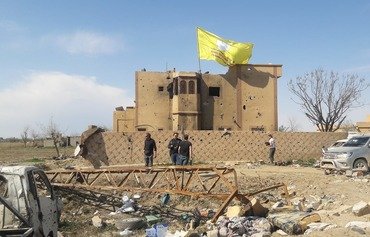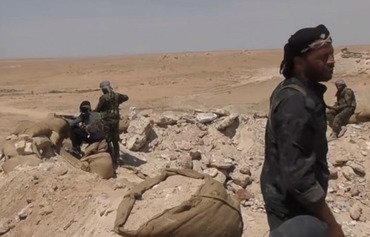One year after the battle for al-Baghouz, Syrians are celebrating their freedom from the "Islamic State of Iraq and Syria" (ISIS) and thanking the Syrian Democratic Forces (SDF) and international coalition for ending their nightmare under the terrorist group.
SDF fighters raised their yellow flag in al-Baghouz, the remote riverside village where extremists from many countries made a desperate last stand, on March 23rd, 2019.
The SDF's victory capped a deadly six-month operation against ISIS, in which the terrorists' brutality included the use of civilians as human shields.
Rooting out ISIS remnants
"The battle to liberate al-Baghouz in Deir Ezzor was a symbolic battle that marked the end of the geographical spread of ISIS in Syria," SDF officer Farhad Khoja told Diyaruna.
![A farmer stands with a spade in a field in the eastern Syrian village of al-Baghouz on March 13th, 2020, a year after the fall of ISIS. [Delil Souleiman/AFP]](/cnmi_di/images/2020/04/08/23367-syria-farmer-baghouz-600_384.jpg)
A farmer stands with a spade in a field in the eastern Syrian village of al-Baghouz on March 13th, 2020, a year after the fall of ISIS. [Delil Souleiman/AFP]
![A view of the destruction in the town of al-Baghouz, where ISIS used civilians as human shields in their last stand against the SDF and international coalition. [Photo courtesy of Euphrates Post]](/cnmi_di/images/2020/04/08/23369-houses-baghouz-syria-600_384.jpg)
A view of the destruction in the town of al-Baghouz, where ISIS used civilians as human shields in their last stand against the SDF and international coalition. [Photo courtesy of Euphrates Post]
"This victory had many pillars, including US-led coalition forces, the SDF, the population of Deir Ezzor who supported the military operations, and of course the tribes who played a prominent role in the battle," he said.
The battle is continuing to eliminate ISIS sleeper cells, which are still trying to launch attacks, and to completely eradicate ISIS's ideology, Khoja said.
"Operations are continuing to root out the group once and for all," he added.
"The Deir Ezzor Military Council is still carrying out the tasks assigned to them and volunteers are coming in droves to join their ranks, particularly tribesmen," Khoja said.
The council's efforts intersect with those made by the Asayish forces, which are charged with maintaining security and social peace, in addition to monitoring any suspicious activity by ISIS remnants and sympathisers, he said.
The operations are succeeding, he said, noting that the number of arrests are declining, indicating that "there are very few sleeper cells left and they have little or no impact".
Meanwhile, life is returning to normal in al-Baghouz as the horrors of the battles subside along with the extremist ideology that prevailed under ISIS's rule, Khoja said.
Nightmare of ISIS is over
"ISIS was a nightmare that has been lifted," said al-Baghouz native Khaled al-Hamada, a fertiliser specialist.
"Everyone in the region has faith in the SDF and coalition forces, and in the victory achieved over [ISIS] that ended its presence and control over territory and people," he told Diyaruna.
"Life post-ISIS is quite different," he said. Under the autonomous administration and local administrations affiliated with it, "each individual bears a responsibility, not only toward himself and his family, but [also] the community as a whole".
"Attempts made by ISIS remnants in the region to distort the truth are countered and refuted by facts," al-Hamada said, describing them as "desperate attempts" to create a rift among the people.
"The people of the region support this transformation and taking part in all civil and military institutions because they ultimately aim to protect and develop the region which has been deprived of the minimum requirements [of life] for decades," he said.
A moment of reflection
The one year anniversary of the liberation of al-Baghouz "calls for a long pause to compare how conditions in the region would have been if [ISIS] was still present, especially in view of the spread of the coronavirus pandemic", said local civil society activist Ammar Saleh.
"The autonomous administration ordered the closure of all [establishments and institutions], imposed a curfew, began disinfecting all areas, and banned travel from one area to another to protect civilians," he told Diyaruna.
"If [ISIS] was present, it would have punished all who do not attend prayer in mosques and its elements would have roamed from one area to another carrying the virus with them and spreading it among civilians," as is happening in areas controlled by militias affiliated with Iran's Islamic Revolutionary Guard Corps (IRGC), he said.
Life has returned to normal "at an accelerated pace", Saleh said.
"Everyone is taking part in the rebuilding process and removal of the remnants of war, in addition to the creation of job opportunities and boosting the agricultural sector -- the main productive sector in the region," he said.
"The tribes also support all the efforts undertaken by the autonomous administration and extend a helping hand to it whenever they can," Saleh said.

![Members of the Syrian Democratic Forces pose next to the SDF's unfurled flag while on watch duty in the village of al-Baghouz in Syria's eastern Deir Ezzor province on March 24th, 2019, a day after ISIS was declared defeated by the US-backed Kurdish-led SDF. [Giuseppe Cacace/AFP]](/cnmi_di/images/2020/04/08/23366-syria-baghouz-sdf-600_384.jpg)






